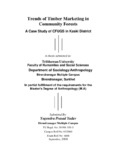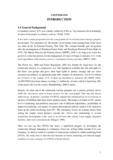Please use this identifier to cite or link to this item:
https://elibrary.tucl.edu.np/handle/123456789/879| Title: | Trends of Timber Marketing in Community Forests : A case study of CFUGS in Kaski district |
| Authors: | Yadav, Yogendra Prasad |
| Keywords: | community;marketing |
| Issue Date: | 2008 |
| Publisher: | Faculty of Humanities |
| Level: | Masters |
| Abstract: | Nepal is surrounded by China and India. West,East,South sides is surrounded by India and North side is China. It is a mountainous country where most of the people are under the poverty line. 80% of the total land has bee covered by hill and mountain. This district is one of the hilly districts and centrally located in western development region. It is situated between 8349' East to 8417' East longitude and 285'North to 2835' North latitude and is approximately rectangle in shape. It shares border with Shyangja in the South, Lamjung and Tanahun in the East, Manang and Mustang in the North and Parbat in the West. The district is divided in 4 constituency and 13 region. There are two municipalities and 43 village development committees in the district. The total households in the district is 67,970 and the total population of the district is 3,66,669 .. The literacy rate of the district is 57%. The total area of Kaski district is 2,01,700 ha of which total forest area is 89,943 ha. There are 8 CFUGs, in average, involved in timber marketing in this district in the five year. The timber trade in highest quantity outside CFUG is done in 063/64 FY year. Similarly, least timber supply outside CFUG is in FY 060/61 (only 55 cft). The analysis shows that Takanja CFUG has sold 11,726 cft of timber alltogether in five year which is 35%. Least is by Satidevi CFUG 1265 cft in five studied fiscal year which comprise only 4%. The demand and supply situation of timber is compatible with the no of hhs. As there increase in hhs no, increase in the demand of timber by CFUGs except CFUGs in Takanja. The share of timber marketing by studied CFUGs is 36% in five year period. The total percentage of timber extraction from the CFs is only 39% than the their stock. This shows that still there is the over stocking of the timber in the studied CFUGs. But it is believed that there is no such stocking as the data presented here; there must be more timber extracted due to the margin in measurement. |
| URI: | http://elibrary.tucl.edu.np/handle/123456789/879 |
| Appears in Collections: | Sociology |
Files in This Item:
| File | Description | Size | Format | |
|---|---|---|---|---|
| Cover Page(6).pdf | 68.21 kB | Adobe PDF |  View/Open | |
| Chapter Page(1).pdf | 604.06 kB | Adobe PDF |  View/Open |
Items in DSpace are protected by copyright, with all rights reserved, unless otherwise indicated.
